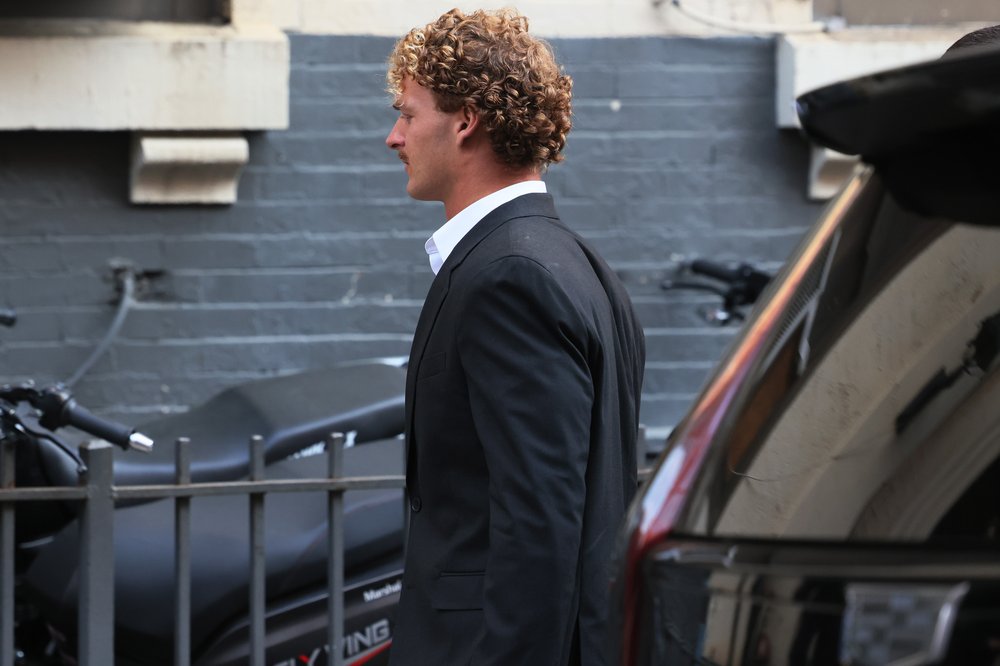Marine who taught Daniel Penny chokehold testifies at NYC trial he didn’t follow procedure
Nov. 14, 2024, 4:13 p.m.
Penny held Neely in a chokehold for about six minutes — including for more than 50 seconds after Neely stopped moving — according to evidence presented in his criminal trial.

The Marine Corps martial arts instructor who trained Daniel Penny in chokehold techniques testified Thursday that the maneuver Penny used to subdue Jordan Neely on an uptown F train in May 2023 didn’t follow his training.
Joseph Caballer, 30, said Marines are taught to use chokeholds that cut off blood flow to the brain within 13 seconds, rendering opponents unconscious. Once that happens, he said, they’re supposed to stop applying pressure immediately. Otherwise, a chokehold could cause injury or death, Caballer said.
In separate testimony Thursday, the homicide detective who interviewed Penny just after the altercation said Penny didn't know Neely had died.
Penny kept Neely in a chokehold for about six minutes — including for more than 50 seconds after Neely stopped moving — according to evidence presented in his criminal trial, which is underway in Manhattan. Caballer said Penny appeared to be using a variation of a technique he learned in training, but that his positioning wasn’t right and at times could have impeded either Neely’s blood flow or his breathing.
“Is it possibly lethal?” Assistant District Attorney Dafna Yoran asked as Caballer looked at an image of Penny with his arm wrapped around Neely’s neck.
“Yes, absolutely,” Caballer said.
Penny, 26, was riding the subway toward SoHo when Neely, 30, boarded and started to yell that he was hungry, thirsty, and willing to die or go to jail, according to witnesses. Within seconds, Penny put Neely in a chokehold, took him to the ground and continued to hold on for several minutes after the train doors opened at the Broadway-Lafayette station. Neely was pronounced dead at a nearby hospital shortly afterward. Penny has pleaded not guilty to manslaughter and criminally negligent homicide charges.
A video of the fatal subway encounter spread online, prompting some to praise Penny’s actions and others to condemn them and call for his arrest. Once Penny’s identity became public, his history in the military raised questions about what training he may have received on using chokeholds.
In court Thursday, Caballer said he trained Penny and other Marines to use different variations of a type of chokehold known as a blood choke. The technique applies pressure to someone’s carotid arteries on both sides of their neck, preventing blood from moving toward their brain. The goal is to briefly render someone unconscious. But if held for too long, he said, a blood choke can be fatal.
Caballer said Marines are sometimes placed in blood chokes during training, but never for more than 5 seconds. When he was placed in one, he said, his forehead began to tingle. He compared the experience to breathing through a crushed straw.
Caballer said Marines don’t learn how to use another type of chokehold, called an air choke, which applies pressure to the trachea and can cut off air to the lungs. That’s because it takes longer for someone to lose consciousness — about two to three minutes — and can also damage the windpipe, he said.
Prosecutors asked Caballer to assess Penny’s technique as he watched a slowed-down version of a video that captured Penny and Neely on the floor. Caballer said it looked like Penny’s arm was at times putting pressure on Neely’s windpipe and at times on at least one of his carotid arteries, but that he didn’t seem to be positioned properly. He said Penny’s elbow didn’t appear to be placed correctly on Neely’s chest, and his hand wasn’t properly pushing down on Neely’s head.
In his cross examination, Penny’s defense attorney, Steven Raiser, also asked Caballer to evaluate Penny’s actions on the video. Raiser's questioning largely focused on whether Penny appeared to be applying pressure at different moments. Caballer noted that at times Penny seemed to be speaking with people around him and moving his head, even as his body was tangled with Neely’s on the floor, suggesting that he might not be exerting himself in those moments.
Raiser also asked whether Penny could have kept Neely in a chokehold without applying pressure, or if he should have released Neely before knowing whether he posed a threat.
“Ultimately that decision depends on him,” Caballer said.
Man admits he lied when he told NYPD that Jordan Neely tried to hit him on the F train Witnesses in NYC subway chokehold case say Jordan Neely’s outburst 'terrified' them